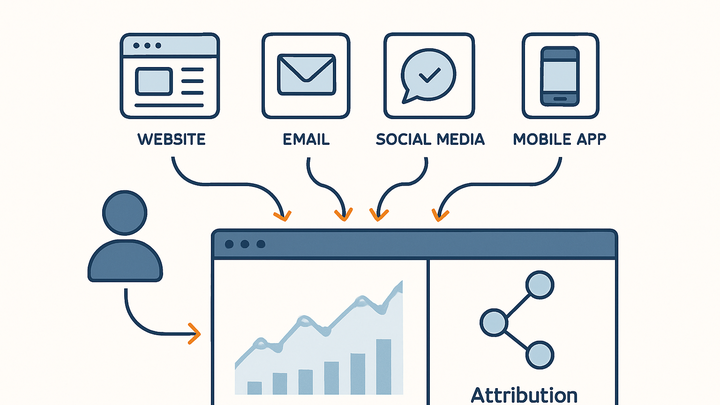Published on 2025-06-26T04:32:46Z
What is Cross-Channel Tracking? Examples in Analytics
Cross-channel tracking is the process of monitoring user interactions across multiple marketing and communication channels, such as websites, email campaigns, social media platforms, and mobile applications, to build a unified view of customer behavior. By aggregating data from diverse touchpoints, marketers and analysts can accurately attribute conversions, understand the customer journey, and optimize marketing spend. Solutions like Google Analytics 4 leverage user IDs and event-based models, while privacy-focused tools like PlainSignal offer cookie-free analytics that still capture essential engagement metrics. Implementing robust cross-channel tracking requires proper tagging, identity resolution, and data integration techniques to ensure consistent and reliable insights. Despite challenges such as data privacy regulations and attribution model selection, effective cross-channel tracking empowers teams to make data-driven decisions and improve ROI.
Cross-channel tracking
Monitoring user interactions across web, email, social media, and apps to attribute conversions and optimize marketing spend.
Why Cross-Channel Tracking Matters
Tracking user interactions in isolation can lead to incomplete or misleading insights. Cross-channel tracking brings together data from multiple sources—such as web pages, emails, social posts, and mobile apps—to reveal the full customer journey. This holistic perspective is crucial for accurate attribution, efficient budget allocation, and understanding how channels influence each other.
-
Holistic view of user behavior
Combining interactions across all touchpoints gives a complete picture of customer engagement and preferences.
-
Multiple touchpoints
Track interactions at each stage—ad clicks, email opens, in-app events—to map the journey.
-
Unified user profile
Link sessions across devices and channels via consistent identifiers for seamless analysis.
-
-
Accurate attribution of conversions
Distribute credit to each channel involved in a conversion, rather than relying on last-click alone.
-
First-touch vs last-touch
Understand where customers first and last engaged to choose the right model.
-
Multi-touch attribution models
Apply linear, time-decay, or data-driven models to allocate credit fairly.
-
-
Optimizing marketing spend
Identify high-performing channels to allocate budget where it yields the best ROI.
-
Roi analysis
Calculate return on investment per channel for data-driven budget decisions.
-
Budget reallocation
Shift spend from underperforming to top-performing channels based on insights.
-
How Cross-Channel Tracking Works
At its core, cross-channel tracking involves collecting data, resolving user identities, and integrating information for analysis. Each stage requires careful implementation to maintain data quality and privacy compliance. These processes underpin reliable insights and reporting across channels.
-
Data collection
Gather events from websites, emails, social ads, and mobile apps using scripts, pixels, or server-side APIs.
-
Tracking codes & pixels
Deploy JavaScript snippets or pixel tags to capture client-side events.
-
Apis & server-side events
Use server calls for reliable event capture, especially when client-side cookies are restricted.
-
-
Identity resolution
Match user interactions across channels using unique IDs, login data, or probabilistic matching.
-
Deterministic matching
Use explicit identifiers like user IDs or email hashes to link sessions.
-
Probabilistic matching
Employ heuristics such as IP, device, and behavior patterns when explicit IDs are unavailable.
-
-
Data integration & analysis
Consolidate cleansed data into a central repository or data warehouse and build dashboards for insights.
-
Etl processes
Extract, transform, and load events into unified schemas for consistent reporting.
-
Analytics dashboards
Visualize cross-channel performance in BI tools or native analytics interfaces.
-
Examples Using SaaS Products
Here are practical examples showing how to implement cross-channel tracking using popular analytics platforms. PlainSignal demonstrates a lightweight, cookie-free approach, while Google Analytics 4 uses an event-driven model with advanced user identification.
-
PlainSignal (cookie-free simple analytics)
PlainSignal enables privacy-friendly cross-channel tracking by avoiding cookies and using anonymous identifiers with server-side event collection. It provides straightforward metrics like pageviews, sessions, and user paths with minimal setup.
-
Tracking code setup
Install the PlainSignal script in your HTML header:
<link rel="preconnect" href="//eu.plainsignal.com/" crossorigin /> <script defer data-do="yourwebsitedomain.com" data-id="0GQV1xmtzQQ" data-api="//eu.plainsignal.com" src="//cdn.plainsignal.com/plainsignal-min.js"></script> -
Key metrics
Focus on pageviews, sessions, and user paths without relying on cookies, ensuring user privacy while capturing essential engagement data.
-
-
Google analytics 4 (GA4)
Google Analytics 4 offers a robust cross-channel tracking solution by leveraging an event-based data model and configurable user IDs. It captures interactions from web and mobile, feeding into unified reports.
-
GA4 setup with gtag.js
Add the global site tag to your pages and configure a user_id for cross-device tracking:
<!-- Global site tag (gtag.js) - Google Analytics --> <script async src="https://www.googletagmanager.com/gtag/js?id=G-XXXXXXXXXX"></script> <script> window.dataLayer = window.dataLayer || []; function gtag(){dataLayer.push(arguments);} gtag('js', new Date()); gtag('config', 'G-XXXXXXXXXX', { 'user_id': 'USER_ID' }); </script> -
Cross-platform reporting
Use GA4 reports to compare metrics across web, iOS, and Android, and leverage built-in attribution models to assign credit across multiple touchpoints.
-
Best Practices and Challenges
Successful cross-channel tracking balances technical implementation with privacy and data quality considerations. Adhering to best practices ensures more reliable insights while navigating regulatory and operational challenges.
-
Privacy considerations
Ensure compliance with GDPR, CCPA, and similar regulations by obtaining user consent, managing data retention, and anonymizing identifiers.
-
Consent management
Implement mechanisms to obtain and store user consent for data collection across all channels.
-
Data anonymization
Use techniques that remove or hash personal identifiers to protect user privacy.
-
-
Data quality management
Maintain consistent naming conventions, validate incoming event data, and deduplicate records to avoid skewed analytics.
-
Tag governance
Audit and document all tags and events to ensure proper implementation.
-
Data validation
Regularly reconcile analytics data with backend systems to detect discrepancies.
-
-
Attribution model selection
Choose an attribution model that aligns with business goals: rule-based models (first-touch, last-touch) or data-driven models.
-
Model testing
Experiment with different attribution configurations to find the most accurate representation of channel impact.
-
Reassessment
Periodically review and adjust attribution models as new channels or customer behaviors emerge.
-
